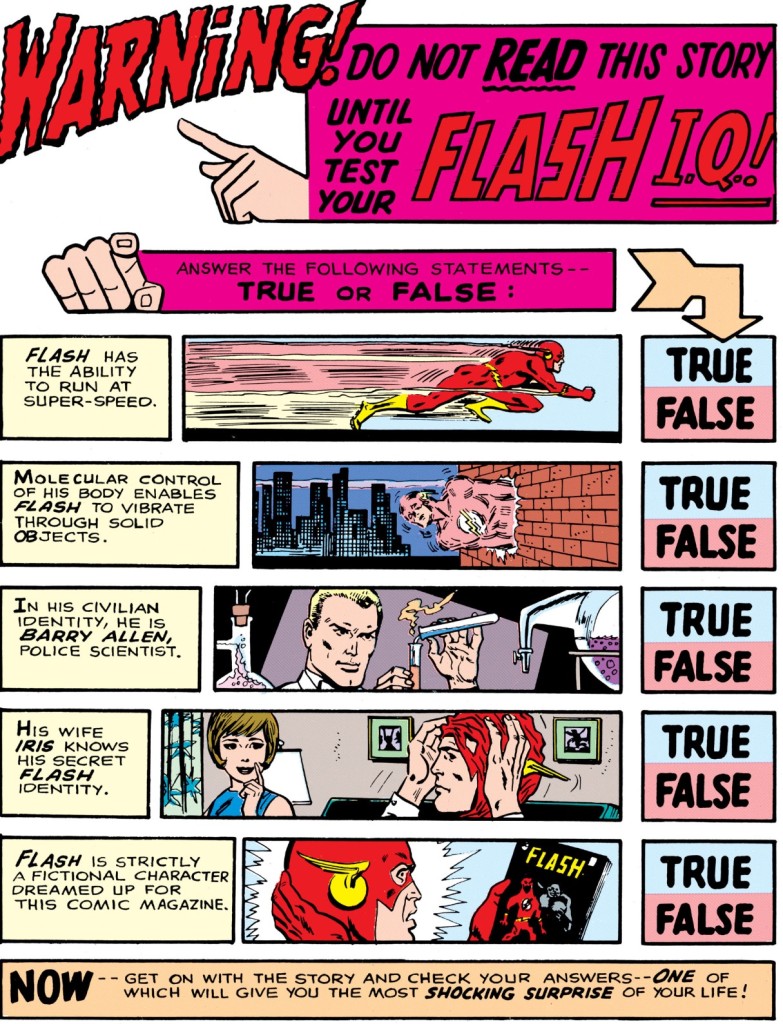 It’s more than a little silly I’m writing a whole post advising you about possible comics to get during this Flash 500 sale Comixology has going on through January 16. Not that I’m writing a whole post about it; more that I’m writing a whole post.
It’s more than a little silly I’m writing a whole post advising you about possible comics to get during this Flash 500 sale Comixology has going on through January 16. Not that I’m writing a whole post about it; more that I’m writing a whole post.
Although it’s glib, I’d say if you thought of Graeme as “the DC guy,” and me as “the Marvel guy,” I think you wouldn’t be entirely right, but I think there might be more truth to that than not. (Although if you think of Graeme as “the smart guy” and me as “the dumb guy, and his self-esteem is problematic too,” I think there’s even more truth to that.)
[More after the jump if you’re inclined; once again, I imaged the crap out of this post…]
But one of the great things about The Flash is that, almost through sheer force of will of his fans, even a boob like me can glean his importance to the state of the modern superhero. For one thing, one of those fans is Grant Morrison, and Morrison has been pretty quick to talk about the silver age Flash book as an influence on how he thinks about comic books.
In fact, one of the most obvious flaws of the Flash 500 sale that even a dilettante fan like myself can notice is the absence of The Flash #163, the cover where The Flash hollers at the reader to “STOP! Don’t pass up this issue!”
This cover is super-clearly the inspiration for that of Ultra Comics #1, the “haunted comic” Morrison puts at the center of Multiversity:
I still can’t figure out why DC didn’t bother to convert that Flash issue—it’s the kind of thing I would’ve gladly paid a penny shy of a dollar for—unless (a) the issue is wayyy too pertinent to Morrison’s haunted comic; or (b) the issue is in no way pertinent. But the choice does raise some issues, however: after all, if you are going to convert a number of issues and debut them especially for a big sale (my lazy count comes to about fifty issues), why wouldn’t you at least include one of the few issues to actually get something like press and internet attention? How do you go about picking the issues that you do?
Fortunately, another idea at the center of Multiversity—that superheroes in one universe are fictional characters in another—also came straight from the pages of The Flash, and there are at least several issues in the sale exploring this idea. The easy pick would be The Flash #123, the comic where Gardner Fox has Barry Allen, The (current) Flash, meet Jay Garrick, The (previous) Flash, on Garrick’s Earth (Earth Two). But if you already have it, or just don’t want to be so obvious, maybe you should check out The Flash #179:
If Wikipedia is to be trusted, this issue is Cary Bates’ first as writer on The Flash, which is kind of a big deal since Bates goes on to write all but four issues of the title between issue #216 and its conclusion at issue #350. And it’s clear from this issue that Bates is not only a fan of the title but also one of the savvier writers to pitch a comic: pursued by an alien creature that feeds off his aura, Flash ends up on Earth Zero, the world where he is a comic book character, and the only person who can help him is the book editor, Julie Schwartz. (Understandably, Schwartz is not introduced committing regrettable acts of sexual harassment.)
A long time ago, I wrote an essay suggesting that while Morrison and Millar at the time were comparing themselves to rock stars, the more accurate analogy would be celebrity chefs since, like chefs, today’s comic book creators make a name for themselves by reinterpreting the standards. And just as a foodie can have one of David Chang’s deconstructed shrimp buns at Momofuku and come back to experience the original in a new light, it’s fun to read The Flash #179 and see the amuse-bouche Morrison has gone on to turn into a nine course meal.
Another influence on Morrison was the book’s casual surrealism, a result of the editors at DC brainstorming ideas for the most eye-catching comic book covers in advance of the stories themselves being written. A lot of times this just resulted in the hero crying, or maybe suddenly strangely fat, or having to flee earth, or suddenly living life as a hobo. But try as they might, it’s pretty hard to beat The Flash #133:
which goes on to get a splash page that doubles down on the concept:
Again, whereas someone like Morrison would take this kind of approach and put it right to the fore, the fifteen page story by John Broome and Carmine Infantino (with Joe Giella on inks) takes its time getting there, and in doing so more or less throws in a bonus genius idea for free: upon his release from prison, Abra Kadabra, the magician from the 64th Century, decides he’s going to go straight and make his name as an entertainer. Soon, he’s packing them in with a puppet show that shows The Flash getting clowned. In the audience, a disgruntled Barry Allen thinks, “It amuses the spectators because it’s so odd to see Flash get beaten.”
So, of course, Barry more or less goes on a full-time crimefighting spree because having The Flash turn into a laughing stock will “severely weaken” “the power of The Flash against crime.” But as The Flash cracks down on crime, people stop showing up to see Kadabra. “I can’t let The Flash triumph over me,” Kadabra thinks. “This has become a personal duel between the two of us.” So, of course, Kadabra uses his super-science-that-is-indistinguishable-from-magic to turn Flash into a sentient puppet. (“As you do,” as Graeme would say.) Not only do the crowds come back now that Flash has apparently vanished, but, as Flash notes while getting kicked around the stage, “Possibly this is the lowest point in my entire career! I’m helpless and contributing to my enemy’s joy and fame!”
Fortunately, Flash has the power of his superior-reasoning-that-is-indistinguishable-from-bullshit and uses the only unaffected part of his body—his brain—to vibrate and shoot spare molecules down into his uniform, allowing it to expand and fill out, giving him the chance to break free, and puppet-punch Kadabra into unconsciousness.
So, yeah. Anyone who wants to do a full-length comic in which the supervillain tries to go straight but can’t because the hero is too insecure to let the villain succeed, go ahead. I’ll just be over here waiting for you with my money.
In this same subset of “crazy covers, desperate stories” is issue #126, where the cover shows the Flash turned into a mirror by The Mirror Master (who else?) who then fires a bazooka at the helpless hero. In this issue, The Mirror Master has discovered that there’s a world inside mirrors: “A sort of fourth dimension of our world that can only be entered through a mirror!”
For those of you who, like me, are excited by the prospect of a silver age Flash story heavily influenced by Jean Cocteau, I warn you you’ll be mostly disappointed. Instead, escaping from prison into the other realm, The Mirror Master discovers a race of telepathic amazons who are transfixed by the sight of their own image in a mirror. (Okay, maybe it’s not a complete disappointment, Cocteau-wise.)
Of course, the Mirror Master is more or less worshiped as a god and given everything he wants…but it turns out all he wants to do is steal stuff. But since the telepathic amazons can read his thoughts, they bring him everything he plans on stealing as soon as he thinks of it. For some reason, however, this telepathy fails them when Mirror Master hatches the idea of tricking Flash to come to the dimension to capture/rescue the villain.
I won’t spoil the scene where The Mirror Master thanks Flash by turning him into a mirror and firing a bazooka at him, but let me just say it is the stuff of a bajillion acid trips. As a bonus, there’s a back-up story about Barry going back to his hometown to visit his parents and meeting up with his first love who is now a rising Hollywood starlet. Consequently, Barry has a nightmare about them being children again and him having to become a child version of The Flash in order to rescue her from a stampeding bull. If I’m understanding the gist of the story’s splash page, the stress of this nightmare makes Barry poop his bed:
It’s actually a pretty good story, even though there’s panel caption that makes me think I might be misunderstanding the whole Barry pooping scenario:
Anyway! If you are in one of those areas of the country where recreational marijuana is legal, or if hasty semi-logical interpretations of partially understood science is a thing that appeals, you might also like issue #125, a comic that has the bonus of being incorrectly cropped for its digital transition, such that a substantial white border surrounds every page, including the cover.
In this issue, Flash recruits Kid Flash to help him fight a war in the far future against the invading Dokris. In order to be safe from the atomic weapons of the people in Earth’s future, the Dokris have sent a hive-shaped object (imaginatively called “The Hive”) far into Earth’s past (100,842,246 B.C.) to “cancel out the radioactivity in the rocks!” (Because “that original radioactivity is the basis of all atomic energy,” we’re told?) (We’re also told this is why atomic power has suddenly failed in the present time, as seen at the beginning of the story…but then wouldn’t have atomic energy have never worked, and wouldn’t even be a thing people would still be doing in the story’s present time?)
It’s one of the best time travel stories I’ve ever read in my life, as it was clearly written by someone who just could not figure out how time travel paradoxes work. (In short, someone like me.) But there’s also a deep misunderstanding of evolution, as when Kid Flash travels to the past and finds, of course, giant ants spinning webs to contain birds with human heads:
But honestly, I wasn’t sold until Kid Flash spends a page and a half pantomiming his mission to the human-headed bird people:
A page and a half. And it’s clear this sequence was written by someone who also doesn’t understand how pantomime works. (In short, someone like me.)
The whole issue feels like an elaborate prank played on the reader, which honestly is a tribute to the stellar work by Infantino and Giella. Infantino’s work feels a bit like an elaborate prank all its own: infused with a quiet dynamism, his layouts perfectly guide your eye through the page, but he won’t hesitate to reposition people and objects in order to keep them “in frame” when he changes up angles. And as a fan of Clowes, I can’t help but dig how Infantino can illustrate the shit out of things, putting them in a strange comic book uncanny valley, where things seem so mundane, they pick up a mysterious appeal all their own. Check out, for example, this panel from the “Barry’s got a prize boner” story, where his ex is busting out her acting chops:
God, I think that’s just some lovely art right there. Partway though my reading, I came up with the phrase “drollpocalypse,” because that pretty much explains the Silver Age Flash vibe: the stories are loaded with surreal imagery they insist are apocalyptic, and then there are some disturbing concepts presented with the most matter-of-fact air, and after a while it becomes hard to tell which is which. (“I’ve got the strangest feeling I’m being turned into a puppet!”)
Anyway, as ever, this post is too long and it’s barely getting started.
If I had the time, I would also recommend issues #275 and #300, written by Cary Bates. Bates has a surprisingly modern sensibility masked under all the superhero worship which leads to some wickedly subversive storytelling, if you’re able to acknowledge it as such. Issue #275, for example, finds the married Flash “compelled” by a teenage girl with ESP to show up a seedy motel and unmask. The girl rejects Barry once she sees his face, deeming it too ordinary (which, in a wonderful touch, deeply wounds Barry).
Not only does the story go on to have some very “Ice Storm” like touches (after patching it up and deciding they should make a baby, Iris and Barry attend a costumed party where Iris gets felt up by a dude dressed like Green Lantern…who turns out to be the real Green Lantern) but it’s also the start of an epic murder mystery. (The issue ends with either Barry or Iris dead, but it won’t say who.)
This is another area where the Flash 500 will let you down: it doesn’t have the next issue in the sale (or on the service) but it does have the issue after that, which opens with The Flash high on angel dust and attacking the Justice League. I cannot tell you how much I want DC to fill in as much of these issues as possible.
And issue #300 sees the return of Carmine Infantino (with Bob Smith) for the awkwardly titled “1981—A Flash Odyssey,” a 48 page story where Barry Allen is a bandaged, paralyzed wreck, long confined to a convalescent clinic ever since the lightning bolt that struck his chemicals caused deep chemical burns and damage to the lumbar region of his spine. Now, a psychiatrist has shown up to help Barry break free from the protective delusion he’s clung to, the delusion that he’s a superhero called The Flash.
The story kinda bumbles the final pages but Bates plays the conceit out longer than you’d think. And, frankly, considering all the terrible science and surreal imagery I’d been exposed to in the issues leading up to this—and many of the stories Barry and the doctor reference in this bottle story are on sale in the Flash 500 (which at least partially answers my earlier question)—the doctor’s explanation makes a lot more sense than the alternative. Again, it’s hard not see the influence this had on Morrison, whose last issue of Doom Patrol takes this idea and demolishes you with it, in a way Bates can only wish he could.
And there’s more! The Superman-Flash races! (I referred to them on Twitter as “The Superman-Flash race issues” and it was promptly brought to my attention how these days the phrase “race issues” has connotations other than what I’d intended.) The Bob Haney Brave & The Bold issues! PROTIP: always buy the Haney Brave & The Bold issues when they’re on sale. They will rarely let you down.
And then there’s, of course, all the modern stuff, some of which I’ve read, but I think you’re in pretty safe hands with Chris Sims’ recommendations over at Comics Alliance, and see also this cracking good piece from The Beast Must Die over at the Mindless Ones that looks at a perfect done-in-one by Morrison and Millar.
Seriously, people: ninety-nine cents an issue through March 16. Think about it.
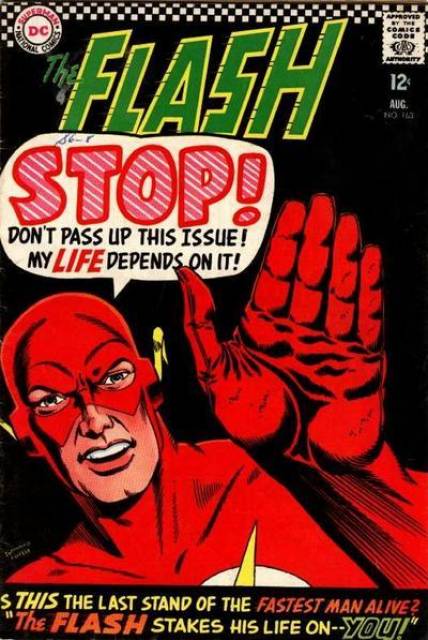
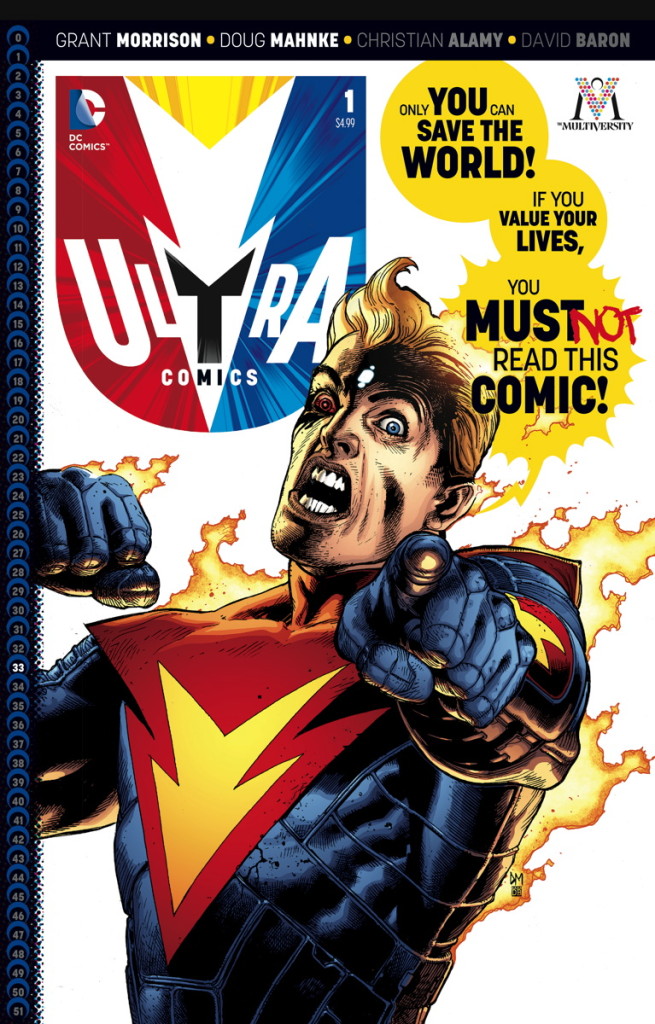
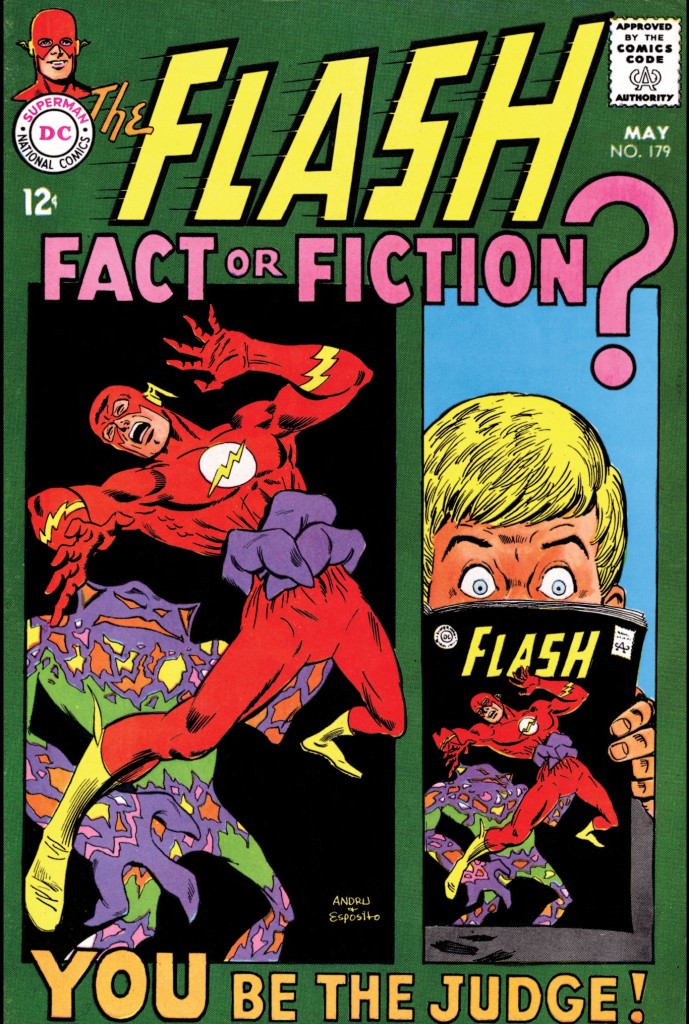
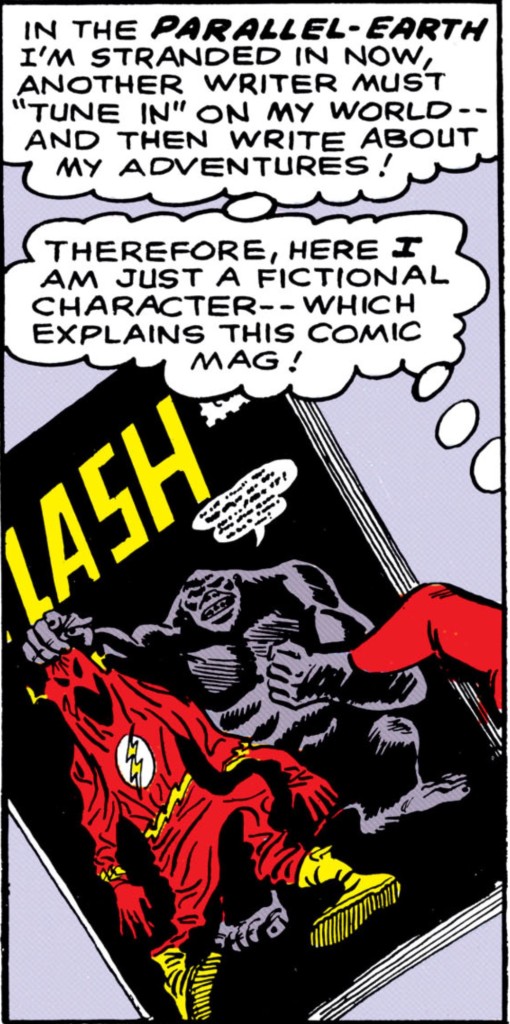
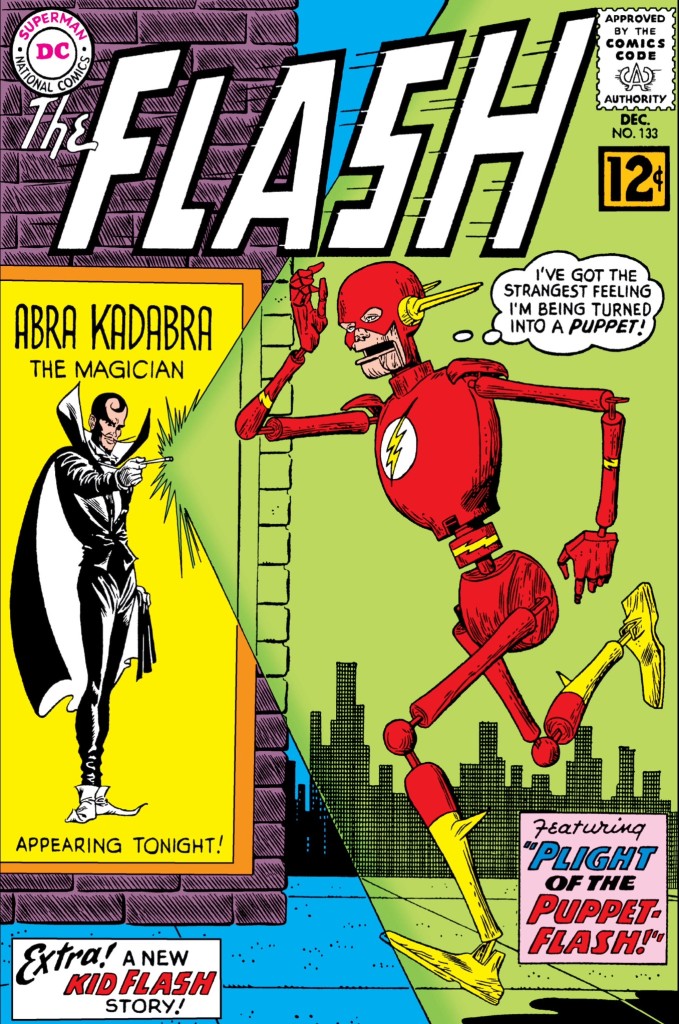
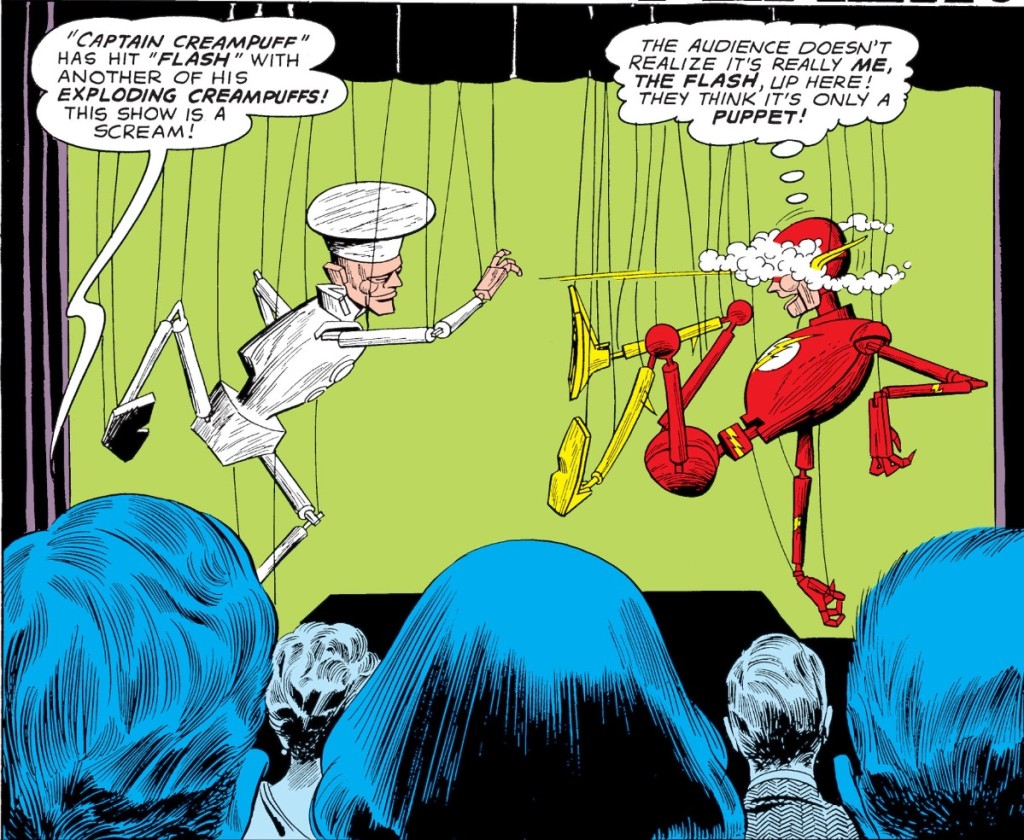
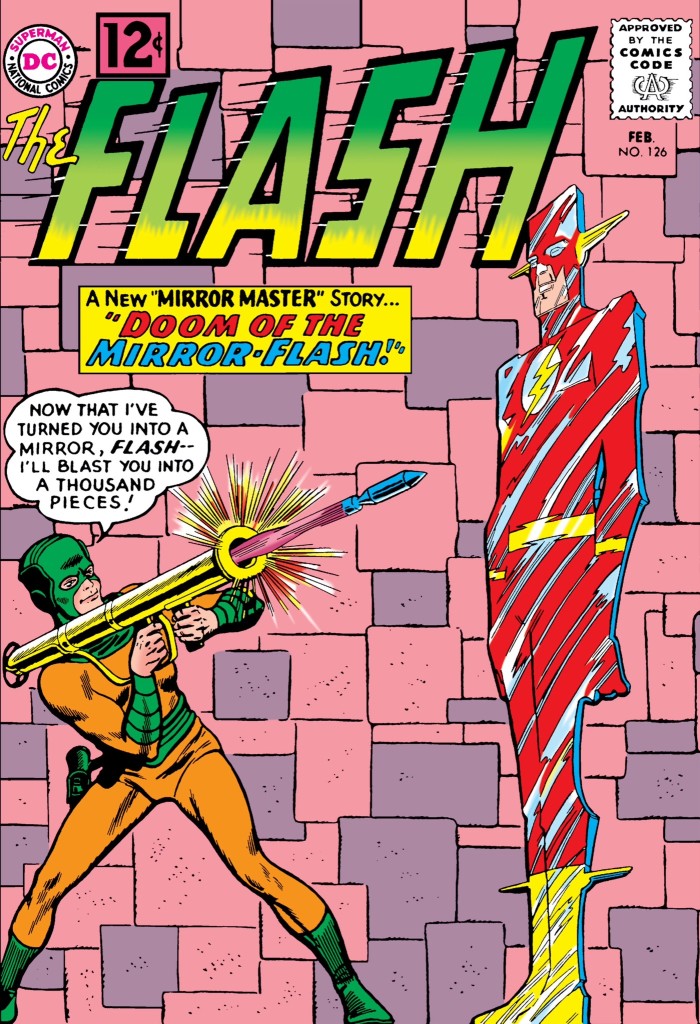
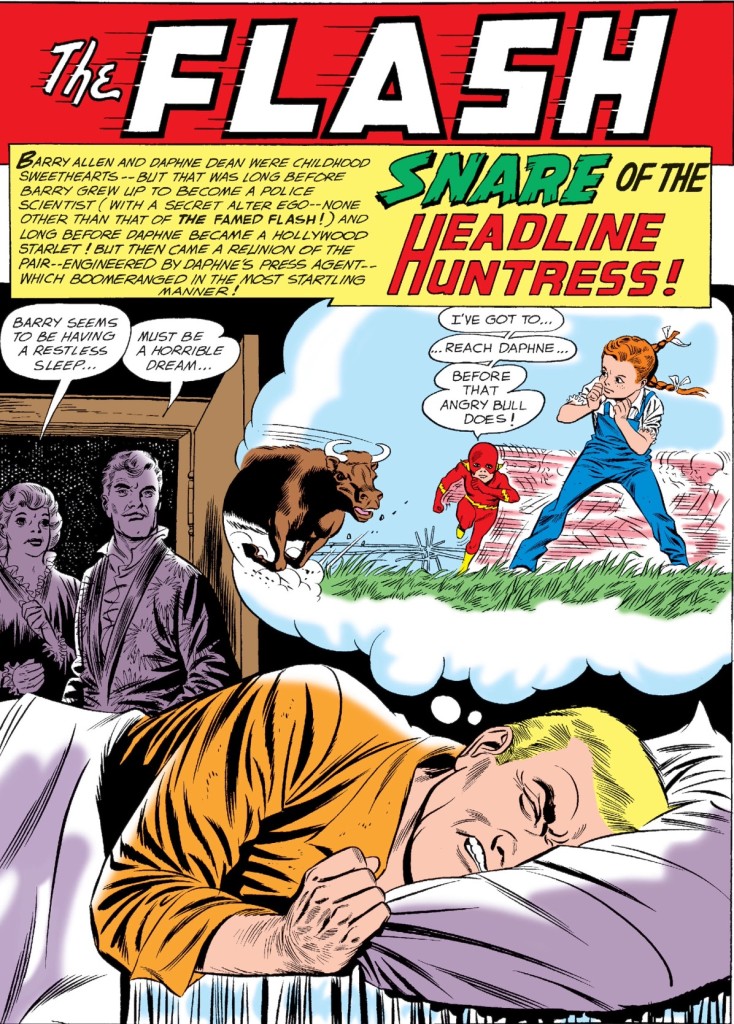
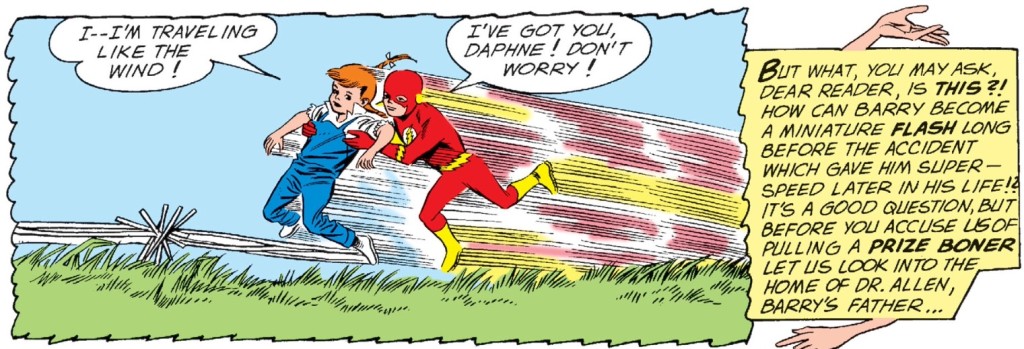
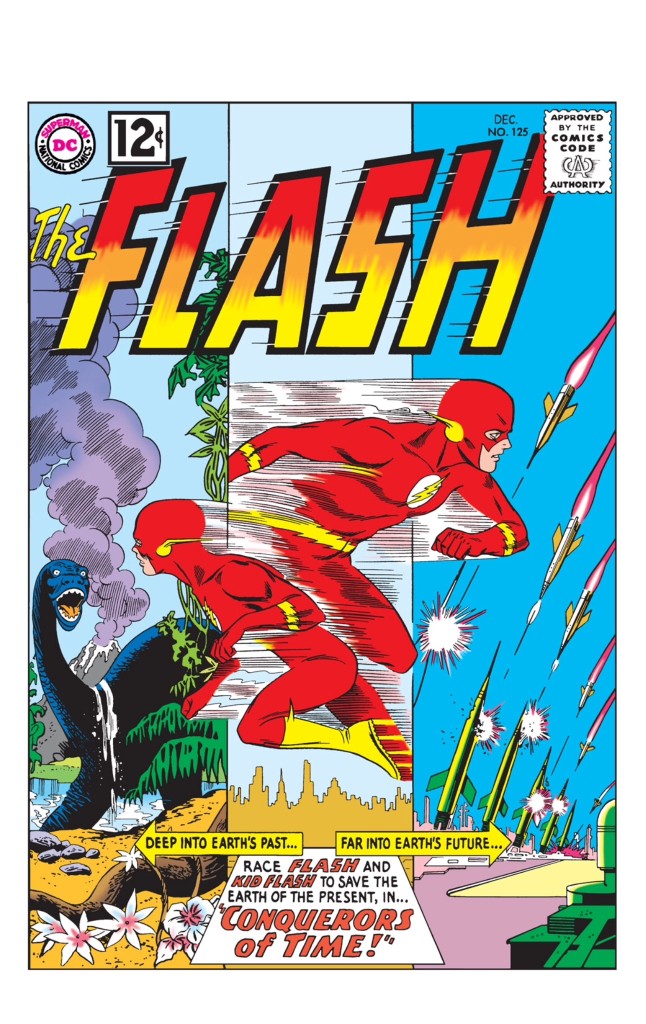
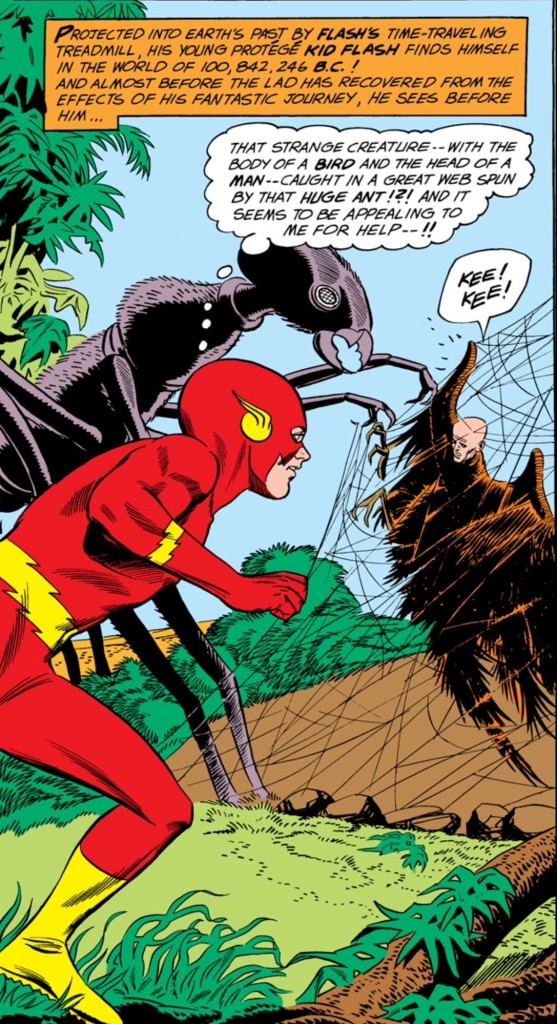
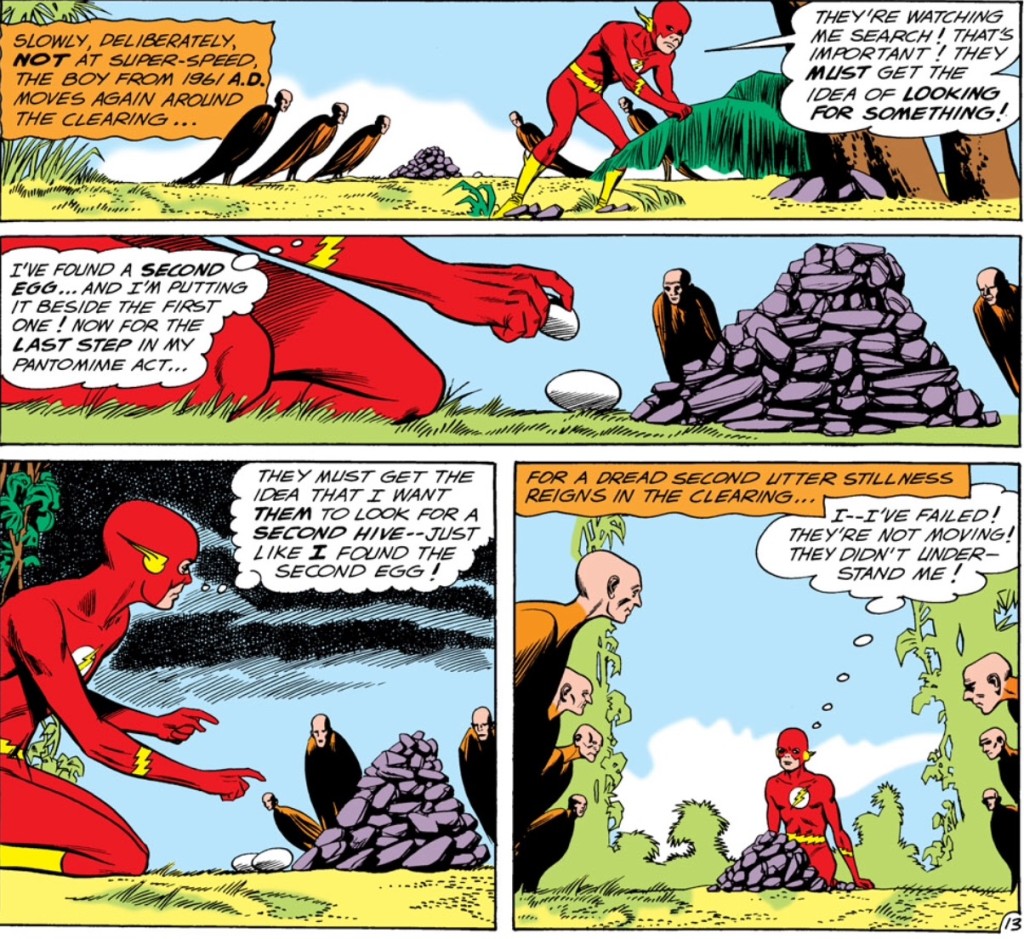
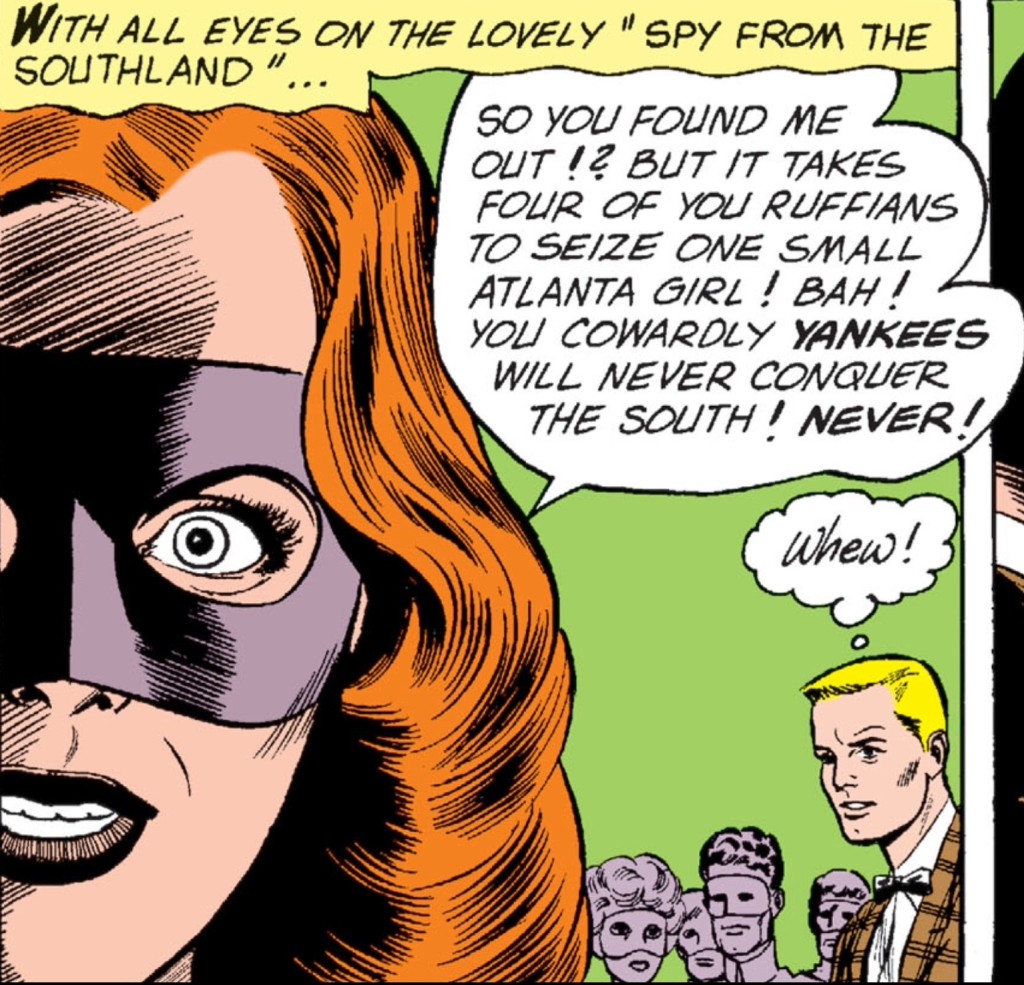
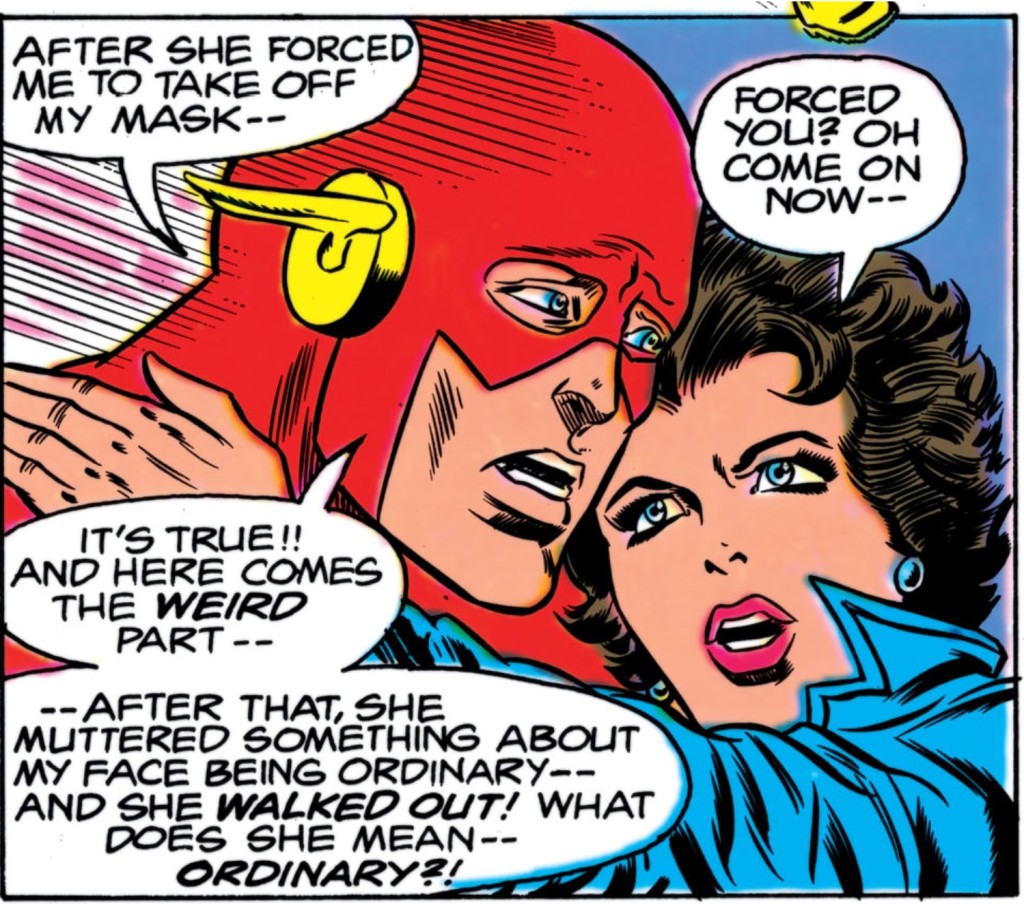
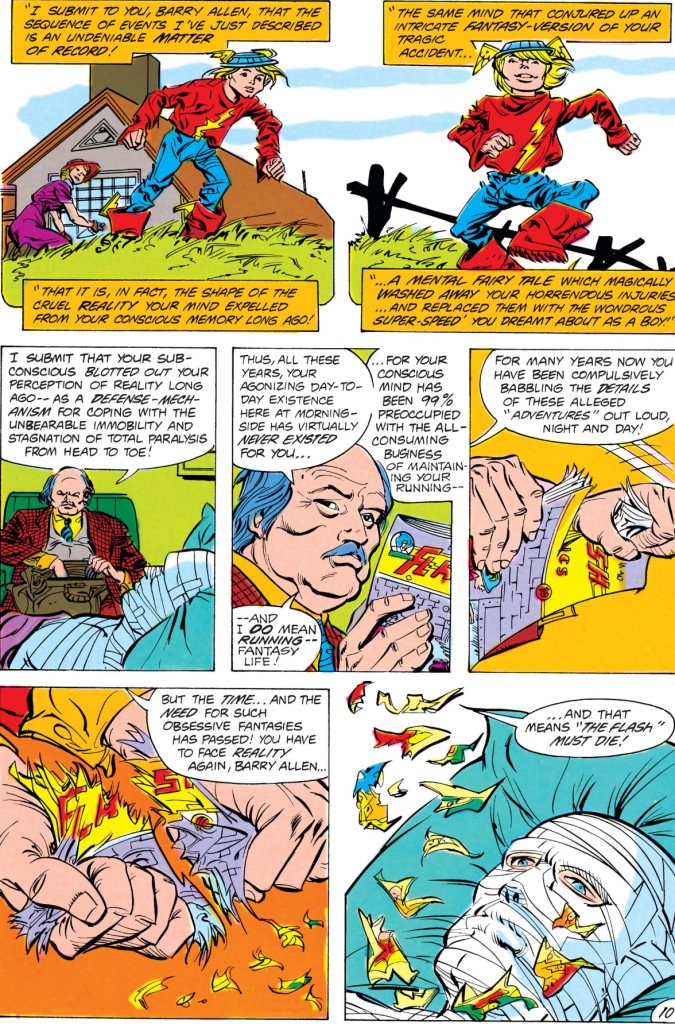


Fun piece, and I agree, the Flash Silver Age issues are a joy. I loved when Flash took the serious turn around the time of Iris’ death, with Barry all Starsky and Hutch. And those human headed birds were obviously Man-Hawks, visiting from the Hawkman series.
That Infantino panel is amazingly Clowes-like, totally nails the distorted drama and restrained paranoia of early Eightball strips.